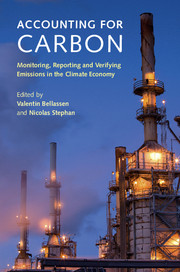Book contents
- Frontmatter
- Contents
- List of figures and map
- List of tables
- List of boxes
- Notes on contributors
- Acknowledgements
- 1 Introduction: key notions and trade-offs involved in MRVing emissions
- Part I MRV of territorial/jurisdictional emissions
- Part II MRV of industrial sites and entities
- 5 Trendsetter for companies and industrial sites: the EU Emissions Trading Scheme
- 6 Variant 1: the waste sector in Australia's Carbon Pricing Mechanism, another ETS at site level
- 7 Variant 2: non-site level emissions in an ETS–the case of electricity importers in the California cap-and-trade
- 8 Variant 3: emissions of a company/institution rather than a site: the case of the Shenzhen ETS
- 9 Variant 4: coexistence of voluntary and mandatory frameworks at the company level - Carbon Disclosure Project, EU ETS and French legal requirements
- 10 Direct measurement in the EU ETS
- Part III MRV at offset project scale
- Index
- References
8 - Variant 3: emissions of a company/institution rather than a site: the case of the Shenzhen ETS
from Part II - MRV of industrial sites and entities
Published online by Cambridge University Press: 05 March 2015
- Frontmatter
- Contents
- List of figures and map
- List of tables
- List of boxes
- Notes on contributors
- Acknowledgements
- 1 Introduction: key notions and trade-offs involved in MRVing emissions
- Part I MRV of territorial/jurisdictional emissions
- Part II MRV of industrial sites and entities
- 5 Trendsetter for companies and industrial sites: the EU Emissions Trading Scheme
- 6 Variant 1: the waste sector in Australia's Carbon Pricing Mechanism, another ETS at site level
- 7 Variant 2: non-site level emissions in an ETS–the case of electricity importers in the California cap-and-trade
- 8 Variant 3: emissions of a company/institution rather than a site: the case of the Shenzhen ETS
- 9 Variant 4: coexistence of voluntary and mandatory frameworks at the company level - Carbon Disclosure Project, EU ETS and French legal requirements
- 10 Direct measurement in the EU ETS
- Part III MRV at offset project scale
- Index
- References
Summary
China's domestic emissions reduction policy
China's unparalleled economic growth has brought with it a massive increase in fossil fuel consumption: China uses almost as much coal as the rest of the world put together. Unsurprisingly, its annual green- house gas emissions surpassed those of the US in 2006 (WRI, CAIT 2.0, 2014). Still, China's negotiators insist on the principle of “common but differentiated responsibility,” stating that industrialized nations have been polluting the atmosphere for the last 150 years and China and other developing countries should therefore have a lesser burden when it comes to reducing consumption of fossil fuels. The failure to include the world's largest emitters–China and the US amount to at least 42 percent of global emissions–into a binding agreement remains one of the major roadblocks of international climate change negotiations.
Interestingly, China's domestic policy is more ambitious than one would assume from its stance on the international stage. While its Copenhagen pledge to reduce its carbon intensity by 40–45 percent compared to 2005 by 2020 was a promising step in the right direction, it was merely a restatement of previously approved domestic policy. China's policy roadmap has included energy intensity targets for already more than a decade, with detailed breakdowns for different sectors and industries. These intensity targets allow continued economic growth, while addressing energy consumption and emissions. Consequently, China has so far not been willing to commit itself to an absolute cap (even assuming a rising trajectory) internationally, although domestically absolute caps on energy consumption or certain fuels are under discussion.
The 10th 5-Year Plan (2001–2005) for example contained an over- all energy intensity reduction target of 24 percent against the baseline year 2000. The target under the 11th 5-Year Plan (2006–2010) was a 20 percent reduction against 2005 levels, a target China barely managed to achieve, having to resort to drastic measures in the last year, such as cutting off electricity supply for factories which had used up their quota (see Box 8.1 “Forced shutdowns under the 11th 5-Year Plan”).
- Type
- Chapter
- Information
- Accounting for CarbonMonitoring, Reporting and Verifying Emissions in the Climate Economy, pp. 263 - 282Publisher: Cambridge University PressPrint publication year: 2015
References
- 1
- Cited by

